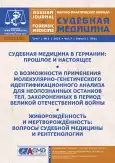Features of the damaging effect of hunting cartridges fired from the KO-98M1 carbine
- Authors: Leonov S.V.1,2, Pinchuk P.V.1,3, Guseva S.V.4
-
Affiliations:
- Main State Center for Forensic Medicine and Forensic Expertise
- Moscow State University of Medicine and Dentistry named after A.I. Evdokimov
- The Russian National Research Medical University named after N.I. Pirogov
- Bureau of Forensic Medical Examination Moscow Health Department
- Issue: Vol 7, No 2 (2021)
- Pages: 108-112
- Section: Case reports
- URL: https://journals.rcsi.science/2411-8729/article/view/122427
- DOI: https://doi.org/10.17816/fm341
- ID: 122427
Cite item
Full Text
Abstract
Background: The article presents the results of experimental studies of gunshot injuries of biological tissue simulators in relation to the morphology of the wound channel, which depend on the characteristics of the cartridge used. Aim: To establish the features of the wound channel in the biological simulator caused by semi-shell bullets of cartridges fired from the KO-98M1 carbine under the 8×57 JS cartridge. Material and methods: Experimental shots were fired with 8×57 JS cartridges with shell and semi-shell bullets from the KO-98M1 hunting carbine. The first group of observations consisted of shots of cartridges with shell bullets of two radius ogival shape; the second group-shots of cartridges with semi-shell bullets with a head part in the form of a truncated cone. Shots with shell bullets of a single-radius ogival form formed the control group. In each group of observations, 10 shots were fired from a distance of 5–10 m, and a pig's half-carcass was used as a target. Results: In the first group of observations, the entrance injury had an oval or rounded shape, with a Central tissue defect with a diameter of 6.5±0.5 mm. the Wound channel from the entrance injury expanded conically and reached a maximum at a distance of 6 cm. In the second group of observations, the entrance gunshot injury had a rounded shape, with multiple radial tears, with a Central tissue defect with a diameter of 7.5±0.5 mm. The wound channel from the entrance injury expanded spherically immediately behind the skin, reaching a maximum at a distance of 4 cm. In the control group of observations, the entrance gunshot injury had a rectangular shape, with one or two radial breaks and a Central tissue defect with a diameter of 5.5±0.5 mm. The wound channel throughout corresponded to the diameter of the firearm shell. Conclusion: In the course of experimental studies, it was found that the rounding of the head part of the shell increases the size of the wound canal cavity by about 4 times. The runway occurs at a distance of 6 cm from the input damage. A semi-shell bullet with a head shape in the form of a truncated cone leads to the formation of a runway immediately behind the layer of skin, while the size of the visible cavity of the wound channel exceeds the size of the projectile by 15 times.
Keywords
Full Text
##article.viewOnOriginalSite##About the authors
Sergey V. Leonov
Main State Center for Forensic Medicine and Forensic Expertise; Moscow State University of Medicine and Dentistry named after A.I. Evdokimov
Author for correspondence.
Email: sleonoff@inbox.ru
ORCID iD: 0000-0003-4228-8973
SPIN-code: 2326-2920
MD, Dr. Sci. (Med.), Professor
Russian Federation, 3 Hospitalnaya Square, Moscow, 105094; MoscowPavel V. Pinchuk
Main State Center for Forensic Medicine and Forensic Expertise; The Russian National Research Medical University named after N.I. Pirogov
Email: pinchuk1967@mail.ru
ORCID iD: 0000-0002-0223-2433
SPIN-code: 7357-3038
MD, Dr. Sci. (Med.), Assistant Professor, Professor
Russian Federation, 3 Hospitalnaya Square, Moscow, 105094; MoscowSvetlana V. Guseva
Bureau of Forensic Medical Examination Moscow Health Department
Email: svetlaguseva@gmail.com
ORCID iD: 0000-0002-1293-0358
Russian Federation, Moscow
References
- Pirogov NI. Military medical practice and private assistance in the theater of war in Bulgaria and in the rear of the active army in 1877–1878. In 2 parts. Saint Petersburg; 1879.
- Callender GR, French RW. Wound ballistics: studies in the mechanism of wound production by rifle bullets. Mil Surg. 1935;77(4):177–201.
- French RW, Callendar GR. Ballistic characteristics of wounding agents. In: Beyer J.C., ed. Wound Ballistics. Washington, D.C.: Superintendentof Documents, U.S. Government Printing Office; 1962.
- Fackler ML. Wound ballistics: A review of common misconceptions. JAMA. 1988;259(18):2730–2736. doi: 10.1001/jama.259.18.2730
- Rybeck B, Janzon B. Absorption of missile energy in soft tissue. Acta Chir Scand. 1976;142(3):201–207.
- Amato JJ, Billy LJ, Lawson NS, Rich NM. High-velocity missile energy: an experimental study of the retentive forces of tissue. Am J Surg. 1974;127(4):454–459. doi: 10.1016/0002-9610(74)90296-7
- Shereshevsky MS. Wound ballistics: Mechanics of the lethal action of bullets and fragments. Moscow: Central Research Institute of Information; 1985. 408 p.
Supplementary files











